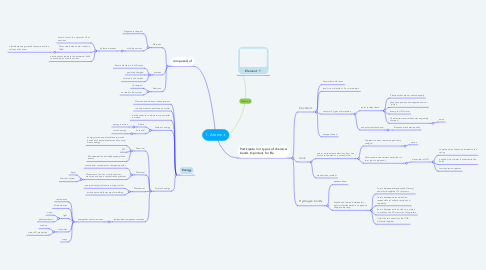
1. composed of
1.1. Electrons
1.1.1. Negatively charged
1.1.2. orbit the nucleus
1.1.2.1. Valence electrons
1.1.2.1.1. atomic mass = # of protons +# of neutrons
1.1.2.1.2. Most stable when outer orbital is filled
1.1.2.1.3. electrons that reside in the outermost shell surrounding an atomic nucleus
1.2. protons
1.2.1. Atomic Number = # of Protons
1.2.2. positively charged
1.2.3. Located in the nucleus
1.3. Neutrons
1.3.1. Uncharged
1.3.2. Located in the nucleus
2. Energy
2.1. No mass and does not take up space
2.2. can only measure its effects on matter
2.3. it is the capacity to do work or put matter in motion
2.4. States of energy
2.4.1. Kinetic
2.4.1.1. energy in action
2.4.2. Potential
2.4.2.1. stored energy
2.5. Forms of energy
2.5.1. Chemical
2.5.1.1. energy stored as potential energy in the bonds of chemical substances becoming kinetic energy
2.5.1.2. ATP
2.5.1.3. Phosphorylation and dephosphorylation events
2.5.2. Electrical
2.5.2.1. results from movement of charged particles
2.5.2.2. Movement of anions or cations across membranes down a concentration gradient
2.5.2.2.1. heart
2.5.2.2.2. Nervous system
2.5.3. Mechanical
2.5.3.1. energy directly involved in moving matter
2.5.3.2. muscles provide the energy for walking
2.5.4. radiant/electromagnetic radiation
2.5.4.1. energy that travels in waves
2.5.4.1.1. radio waves
2.5.4.1.2. infrared waves
2.5.4.1.3. light
2.5.4.1.4. ultraviolet
2.5.4.1.5. x-rays
3. Element
4. Participate in 3 types of chemical bonds important for life
4.1. Covalent
4.1.1. Atoms share electrons
4.1.2. result in a molecule of 2 or more atoms
4.1.3. can form 2 types of molecules
4.1.3.1. polar covalent bond
4.1.3.1.1. Electrons that are not shared equally
4.1.3.1.2. they have positive and negative ends or "poles"
4.1.3.1.3. example: H2O water
4.1.3.1.4. The electron receiver becomes negatively charged
4.1.3.2. nonpolar covalent bond
4.1.3.2.1. Electrons are shared equally
4.1.4. strongest bond
4.2. Ionic
4.2.1. one or more valence electrons from one atom are donated to a second atom
4.2.1.1. The electron donor becomes positively charged
4.2.1.1.1. cation
4.2.1.2. Cations and anions attract each other to form ionic compounds
4.2.1.2.1. dissociate in H2O
4.2.2. weaker than covalent
4.3. Hydrogen bonds
4.3.1. weakest bond
4.3.2. Weak bond formed between two polar molecules based on opposite charges attracting
4.3.2.1. Forms between electropositive H atoms and electronegative O or N atoms
4.3.2.2. Forms between water molecules; responsible for surface tension and capillarity
4.3.2.3. Forms between amino acids on a protein to produce the 3D structure of the protein
4.3.2.4. Holds the two strands of the DNA molecule together

